Citroën Méhari
The Citroën Méhari is a lightweight utilitarian and recreational vehicle manufactured and marketed by Citroën over 18 years in a single generation in two-wheel (1968-1988) and four-wheel drive (1980-1983) variations — noted for its doorless ABS plastic bodywork and foldable, stowable, fabric convertible top.
| Citroën Méhari | |
|---|---|
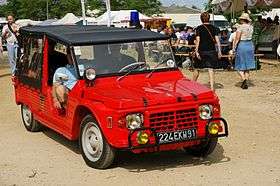 | |
| Overview | |
| Manufacturer | Citroën |
| Production | 1968—1988 |
| Assembly |
|
| Designer | Roland de La Poype |
| Body and chassis | |
| Class | Off-road compact SUV (J) |
| Body style | 2-door utility roadster |
| Layout | Front engine, front-wheel drive / four-wheel drive |
| Platform | Citroën 2CV platform |
| Related |
|
| Powertrain | |
| Engine | 602 cc flat-2 |
| Dimensions | |
| Wheelbase | 2,400 mm (94.5 in) |
| Length | 3,520 mm (138.6 in) |
| Width | 1,530 mm (60.2 in) |
| Height | 1,640 mm (64.6 in) |
| Curb weight | 570 kg (1,256.6 lb) |
| Chronology | |
| Successor | Citroën C-Crosser Citroën E-Méhari |
The Méhari weighed approximately 535 kg (1,179 lb), featured the fully independent suspension shared with Citroën 'A-Series' vehicles, shared its chassis with the Dyane 6 and the 602 cc (36.7 cu in) flat twin petrol engine shared with the 2CV6 and Ami.
Named after the fast-running dromedary camel, Citroën manufactured 144,953 Méharis between the car's French launch in May 1968[1] and end of production in 1988.[2]
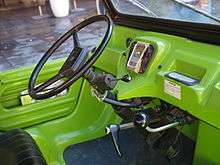
History
Origin
The Méhari was designed by French World War II fighter ace Count Roland de la Poype, who headed the French company SEAP - Société d'Etudes et d'Applications des Plastiques. This company was already a supplier to Citroën, and SEAP developed a working concept of the car before presenting it to its client.[3]
Post-production
The Méhari ended production in 1988 with no replacement. This left a gap in the market, that others have tried to address.
The Teilhol company, which had been building the recently defunct Renault Rodeo, created the Tangara using 2CV mechanicals, with bolt on pre-dyed GRP panels. It also created a Citroën AX-based model. The company ceased operations in 1990.[4]
Due to its mechanical simplicity the Méhari can be restored to ‘as new’ condition – all parts including the chassis are easily available, creating a thriving restoration market.[5]
Variants
Méhari 4x4
In 1979, Citroën launched the Méhari 4x4 with drive to all four wheels. Unlike the Citroën 2CV Sahara 4x4, this car had only one engine, rather than one engine per axle.
The body is distinguished by its spare wheel mounted on the specially designed bonnet, its additional bumpers, front and rear, its flared wheel arches (for 1982), big optional tyres (for 1982) and tail lights similar to the Citroën Acadiane van.[6] The 4x4 version has a gearbox with four normal speeds and a three-speed transfer gearbox for crossing slopes up to 60%. At the time, the Méhari 4x4 was one of the few 4x4s with four-wheel independent suspension. The car had all wheel disc brakes.[7]
Méhari 4x4 production stopped in 1983.
Limited editions
Two limited edition versions of the Méhari were sold: the first was the white and blue Méhari Azur (Blue), of which 700 were sold, and the all-yellow Méhari Plage (Beach), produced for the Spanish and Portuguese market, of which only 500 were sold.
Sale
United States
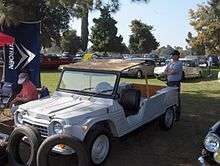
Citroen marketed the Méhari in the United States for model years 1969-1970, where the vehicle was classified as a truck. As trucks had far more lenient National Highway Traffic Safety Administration safety standards than passenger cars in the US, the Méhari did not have seat belts. Budget Rent-A-Car offered them as rentals in Hawaii. Hearst Castle, in San Simeon, California, used them as groundskeeper cars.[8]
Revisions for the US market included:
- Altered front panel with larger 7" sealed-beam headlamps
- Lateral side marker lights
- Special boot lid with room for US registration plate and a lamp (Lucas) either side of it.
- Straight rear bumper.
- Two-speed wiper motor.
- Reversing lights.
- Hexagonal yellow "cats eyes" on front and rear sides.
South America

The Méhari sold in Argentina had a fibreglass body rather than ABS. The car was produced in Uruguay from 1971 to 1979. After Citroën left Argentina following the collapse of the economy in the late 1970s, the production of the Méhari, renamed the "Méhari Ranger" with flared wheel arches and big tires, continued for some time.
Military
The French Army purchased 7,064 Méharis - some of which were modified to have 24 V electric power.[3] The Citroën Méhari was also in service with the Irish Defence Forces, which bought a total of 12 vehicles in the late 1970s; most were sold at auction about 1985, but one is retained at the DFTC in the Curragh Camp, County Kildare, Ireland.
Production
Colours
The car's colour was integrated into the ABS plastic during production, with limited color choices. One color, Vert Montana, remained a choice throughout production. Except for the limited edition Azur, the official names of colours all refer to desert regions.
As ultraviolet sunlight degrades the colorfastness of ABS plastic, unrestored cars may have faded.[8] New bodies for restorations are available in various original colours.
| Colour | Years | ||
|---|---|---|---|
| Rouge Hopi | 1968-1975 | 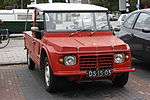 | |
| Vert Montana | 1968-1987 | ||
| Beige Kalahari | 1968-1977 | ||
| Orange Kirghiz | 1969-1987 |  | |
| Vert Tibesti | 1976-1979 | 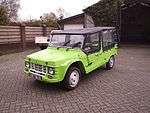 | |
| Beige Hoggar | 1978-1987 |  | |
| Jaune Atacama | 1980-1987 |  | |
| Azur | 1983-1987 | ||
Sales figures
| Year | 1968 | 1969 | 1970 | 1971 | 1972 | 1973 | 1974 | 1975 | 1976 | 1977 | 1978 | 1979 | 1980 | 1981 | 1982 | 1983 | 1984 | 1985 | 1986 | 1987 | Total |
| Méhari | 837 | 12,624 | 11,246 | 10,175 | 11,742 | 12,567 | 13,910 | 8,920 | 9,569 | 9,645 | 8,467 | 8,995 | 8,351 | 4,833 | 4,137 | 3,349 | 2,654 | 1,882 | 669 | 381 | 144,953[9] |
Paris arson incident
- In 1973-1974, 63 Citroën Méhari were burned by an arsonist in Paris.[10]
References
- "Méhari". L'Auto-Journal: Le Salon de l'auto 1974. Numero Special: Page 89. September 1974.
- Cars & parts - Volume 13 1969, p.23.
- Par Nicolas MeunierVoir tous ses articles (22 May 2013). "Citroën Méhari : les 45 ans de la voiture en plastique". Challenges. Retrieved 5 September 2015.
- "Teilhol Tangara". Retrieved 5 September 2015.
- "2CV MEHARI CLUB CASSIS - Vente et Achat des pièces 2CV et Méhari". Retrieved 5 September 2015.
- "Citroën Méhari page 1". Retrieved 5 September 2015.
- "Citroën Méhari page 5". Retrieved 5 September 2015.
- "Guide to Citroens in North America". Retrieved 5 September 2015.
- "Production numbers from Citroenet". Citroën statistics. Citroenet.org. Retrieved 6 December 2012.
- "EN IMAGES. La Méhari fête ses 45 ans". leparisien.fr. 16 May 2013. Retrieved 5 September 2015.
External links
| Wikimedia Commons has media related to Citroën Méhari. |
- Méhari at Citroenet
- Méhari links at Citroën World
- Restored Mehari in France
- Méhari modelcars
- IMCDB.org